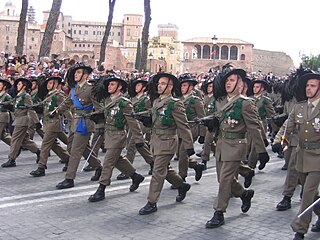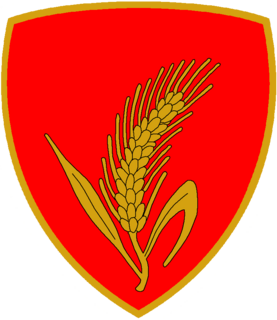
A lancer was a type of cavalryman who fought with a lance. Lances were used for mounted warfare in Assyria as early as 700 BC and subsequently by Persia, India, Egypt, China, Greece, and Rome. The weapon was widely used throughout Eurasia during the Middle Ages and the Renaissance by heavy cavalry, before being adopted later on by light cavalry. In a modern context, a lancer regiment usually denotes an armoured unit.

The Bersaglieri, singular Bersagliere,, "sharpshooter") are a speciality of the Italian Army's infantry corps. They were originally created by General Alessandro La Marmora on 18 June 1836 to serve in the Royal Sardinian Army, which later became the Royal Italian Army. They can be recognized by their distinctive wide-brimmed hats decorated with black capercaillie feathers, which is worn with the dress uniform. The feathers are also applied to their combat helmets.

The 8th Alpini Regiment is a regiment of the Italian Army's mountain infantry speciality, the Alpini, which distinguished itself in combat during World War I and World War II.

The 3rd Field Artillery Regiment (Mountain) is a field artillery regiment of the Italian Army, specializing in mountain combat. The regiment was raised in 1902 as 3rd Mountain Artillery Regiment to support the Italian Army's mountain infantry troops, the Alpini, with whom the regiment shares the distinctive Cappello Alpino. Both, the Alpini and the Mountain Artillery, distinguished themselves in World War I and World War II. The regiment is the highest decorated artillery regiment of the army, having earned two Gold Medals of Military Valour in World War II: the first for the unit's conduct during the Greco-Italian War, the second for its service with the Italian Army in Russia. Today the regiment is based in Remanzacco in Friuli-Venezia Giulia and operationally assigned to the Alpine Brigade "Julia". It is notable that Enzo Ferrari served in this regiment during World War 1.

The 11th Alpini Regiment is an inactive regiment of the Italian Army's mountain infantry speciality, the Alpini, which distinguished itself in combat during World War I and World War II.

The Mechanized Brigade "Granatieri di Sardegna" is a mechanized infantry brigade of the Italian Army, based in Rome and central Italy. The brigade fields one of the oldest regiments of the Army and is one of the guard regiments of the President of Italy. The name of the unit dates back to the Kingdom of Sardinia and not the eponymous Mediterranean island of Sardinia. The brigade is part of the Division "Acqui".

The Mechanized Brigade "Aosta" is a mechanized infantry brigade of the Italian Army based on the island of Sicily. The Brigade is one of the oldest of the Italian Army and the name connects the brigade to its original area of recruitment the Aosta Valley and therefore the brigade's coat of arms is modeled after the coat of arms if Aosta. The brigade is part of the Division "Acqui".

The 1st Cavalry Division "Eugenio di Savoia" was a cavalry or "Celere" (Fast) division of the Royal Italian Army during World War II. The Eugenio di Savoia was mobilized in 1940 and took part in the Invasion of Yugoslavia. The division was assigned to the XI Corps in Ljubljana and remained in Yugoslavia as occupation force on the Dalmatian coast. After the Armistice of Cassibile on 8 September 1943 the division was disbanded by the Germans.

After World War II the Italian Army had two units named "Centauro": from 1952 to 1986 the Armored Division "Centauro" and from 1986 to 2002 the Armored Brigade "Centauro". Both units were successor to the World War II era 131st Armored Division "Centauro". The units' name came from the mythological race of half human-half horse creatures named Centaurs.

The Armored Brigade "Vittorio Veneto" was an armored brigade of the Italian Army. Its core units were armored and mechanized cavalry squadrons groups. The brigade's headquarters was in the city of Villa Opicina, with most of its units based in the Province of Trieste. The brigade's name was chosen to remember the decisive Italian World War I victory at the Battle of Vittorio Veneto.

The 32nd Armored Brigade "Mameli" was an armored brigade of the Italian Army. Its core units were tank and Bersaglieri battalions. The brigade was headquartered in the city of Tauriano, a subdivision of the city of Spilimbergo. All the brigade's units were based in Spilimbergo. The brigade's name was chosen to honor the Italian patriot Goffredo Mameli writer of the lyrics of the Italian national anthem. The brigade's sister brigades, the 132nd Armored Brigade "Manin" and 8th Mechanized Brigade "Garibaldi" were named to honor of Daniele Manin and Giuseppe Garibaldi, both heroes of the Italian unification.

The 132nd Armored Brigade "Ariete" is currently the only active armored brigade of the Italian Army. Its core units are tank and Bersaglieri regiments. The brigade's headquarters is in the city of Pordenone and most of its units are based in the North-East of Italy. The brigade's name comes from the battering ram. The brigade draws much of its historical traditions from the 132nd Armored Division "Ariete", which fought in the Western Desert Campaign of World War II. In 1948 the Ariete was reconstituted as division and remained active until 1986. Today the brigade is part of the Division "Vittorio Veneto".

The Mechanized Brigade "Brescia" was a mechanized brigade of the Italian Army. Its core units were mechanized infantry battalions. The brigade was founded in, named after, and headquartered in the city of Brescia and accordingly the brigade's coat of arms was modeled after the city's coat of arms.

The Mechanized Brigade "Legnano" was a mechanized brigade of the Italian Army. Its core units were mechanized infantry battalions. The brigade's headquarters was in the city of Bergamo in Lombardy. The name of the brigade commemorates the Lombard League victory in the Battle of Legnano in 1176 and its coat of arms depicts the Monument to the Warrior of Legnano in the centre of Legnano.

The Motorized Brigade "Cremona" was an infantry brigade of the Italian Army. The brigade's headquarters was in the city of Turin. The brigade carried on the name and traditions of the 44th Infantry Division "Cremona".

The Mechanized Division "Folgore" was a mechanized division of the Italian Army. Its core units were three mechanized brigades. The brigades headquarters was in the city of Treviso.

The Mechanized Brigade "Isonzo" was a short-lived brigade of the Italian Army created during the 1975 army reform and renamed Mechanized Brigade "Mantova" during the 1986 army reform. The name of the brigade was chosen to commemorate the twelve Battles of the Isonzo during World War I.
The Battle of Campo delle Mosche took place on 23 July 1359 in the district of Pontedera in the state of Pisa, Italy between the forces of Florence and those of the mercenary Great Company. It resulted in a victory for the Florentine forces.
With the 1975 reforms the Italian Army abolished the regimental level and replaced it with brigades made up of multiple arms. During the reform the army disbanded 48 regimental commands and reduced its force by 87 battalions. A further ten regimental commands were used to raise ten new brigade commands. Ten training centers, which for traditional reasons had carried the names of regiments, were also disbanded. The reduction in units also allowed to mechanize most of the remaining units in Northern Italy and Italy's defense strategy changed from a hold-at-all-costs territorial defense to one of mobile warfare.

Italian Army gorget patches are worn by all army personnel on the collars of the shirts and jackets of their service uniforms and formal uniforms. The gorget patches identify the arm, corps, or speciality within an arm or corps a soldier belongs to. Generals wear golden stars instead of a gorget patches, while army recruits wear silver stars until they are assigned to a unit after basic training. Originally made from colored cloth, respectively embroidered cloth for Granatieri, Carabinieri and general staff members, gorget patches have been made since 1973 from enamelled metal.